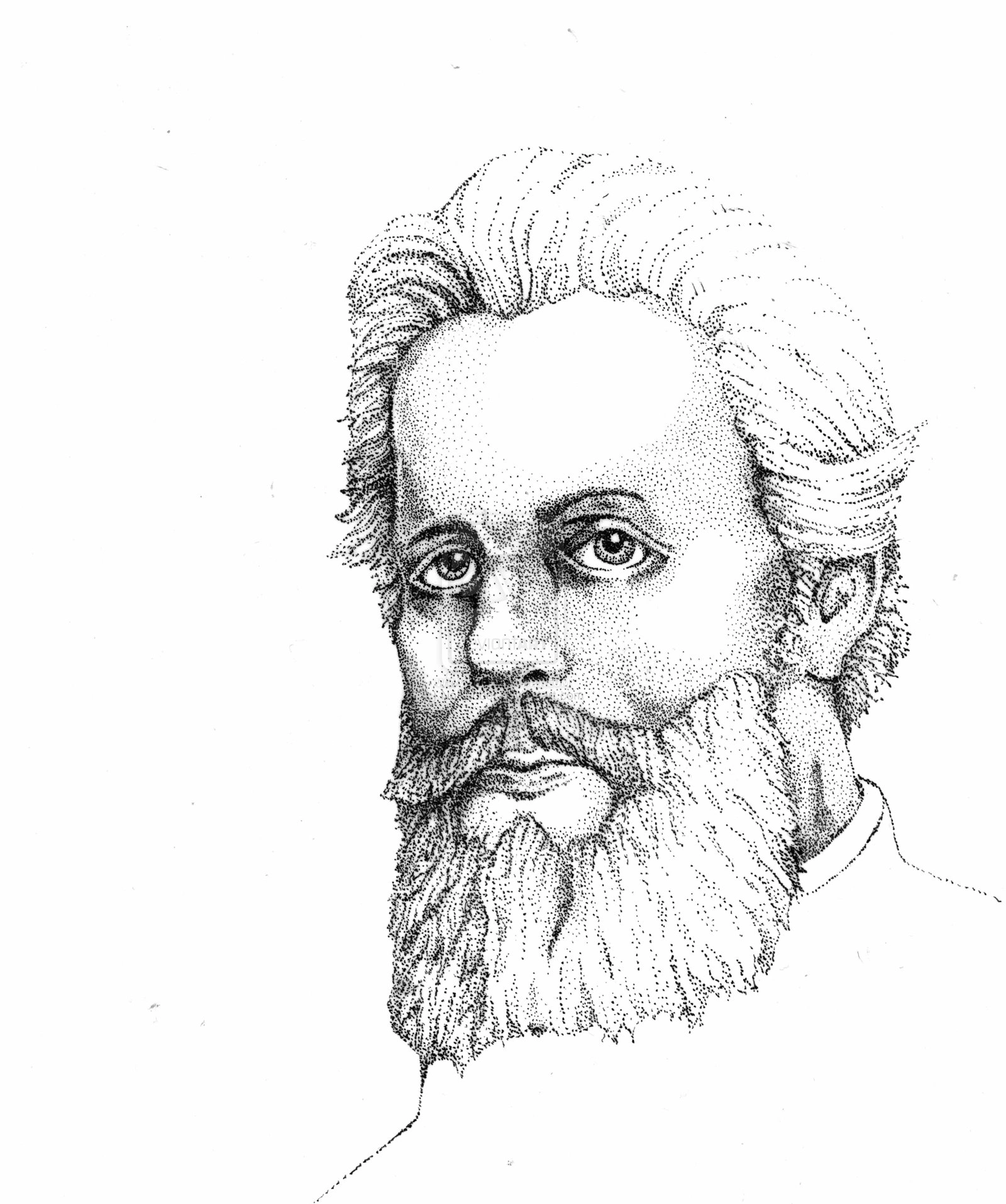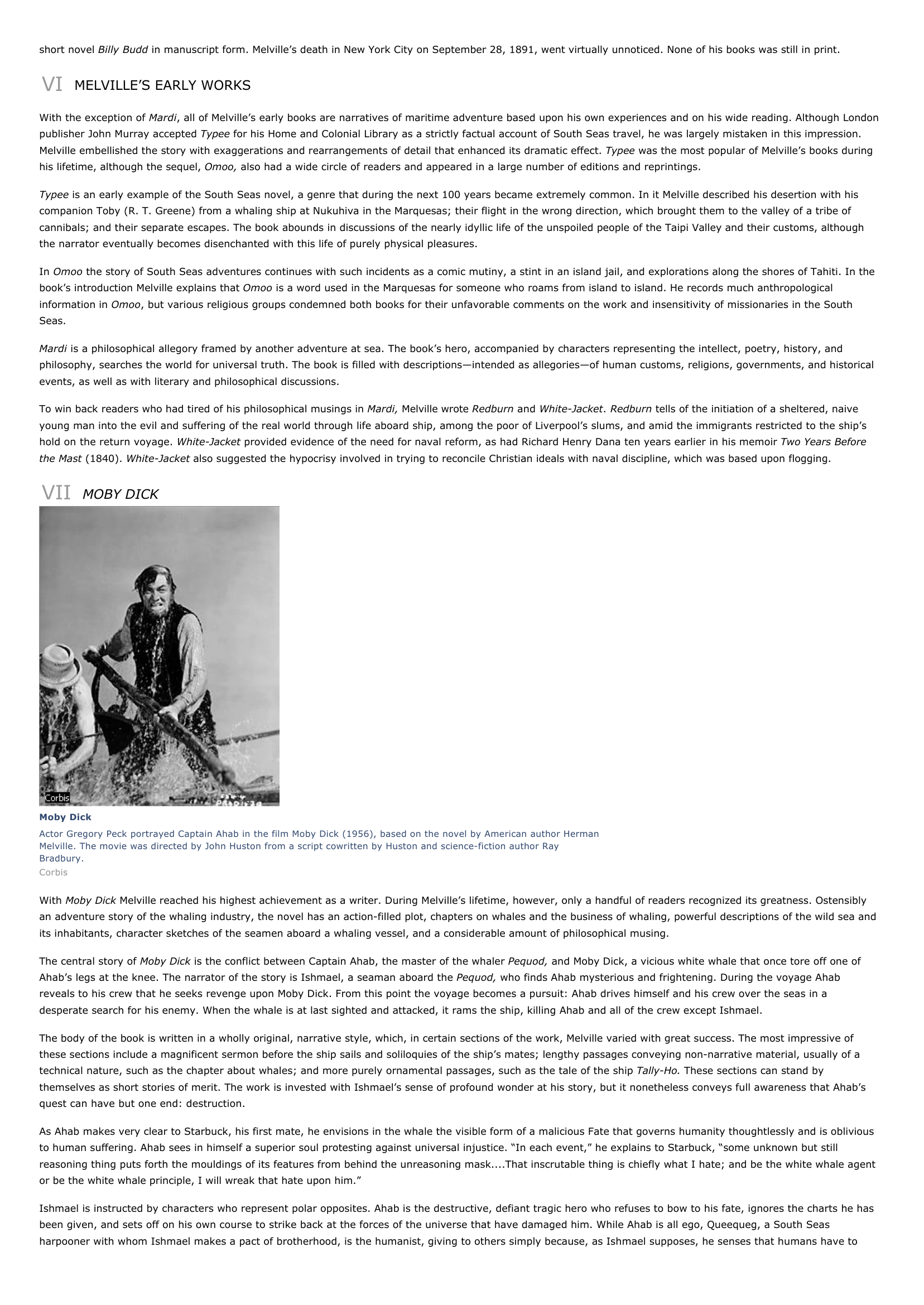Herman Melville I INTRODUCTION Herman Melville These lines (recited by an actor) begin the novel Moby Dick (1851), by Herman Melville.
Publié le 12/05/2013

Extrait du document


«
short novel Billy Budd in manuscript form.
Melville’s death in New York City on September 28, 1891, went virtually unnoticed.
None of his books was still in print.
VI MELVILLE’S EARLY WORKS
With the exception of Mardi , all of Melville’s early books are narratives of maritime adventure based upon his own experiences and on his wide reading.
Although London publisher John Murray accepted Typee for his Home and Colonial Library as a strictly factual account of South Seas travel, he was largely mistaken in this impression. Melville embellished the story with exaggerations and rearrangements of detail that enhanced its dramatic effect.
Typee was the most popular of Melville’s books during his lifetime, although the sequel, Omoo, also had a wide circle of readers and appeared in a large number of editions and reprintings.
Typee is an early example of the South Seas novel, a genre that during the next 100 years became extremely common.
In it Melville described his desertion with his companion Toby (R.
T.
Greene) from a whaling ship at Nukuhiva in the Marquesas; their flight in the wrong direction, which brought them to the valley of a tribe ofcannibals; and their separate escapes.
The book abounds in discussions of the nearly idyllic life of the unspoiled people of the Taipi Valley and their customs, althoughthe narrator eventually becomes disenchanted with this life of purely physical pleasures.
In Omoo the story of South Seas adventures continues with such incidents as a comic mutiny, a stint in an island jail, and explorations along the shores of Tahiti.
In the book’s introduction Melville explains that Omoo is a word used in the Marquesas for someone who roams from island to island.
He records much anthropological information in Omoo , but various religious groups condemned both books for their unfavorable comments on the work and insensitivity of missionaries in the South Seas.
Mardi is a philosophical allegory framed by another adventure at sea.
The book’s hero, accompanied by characters representing the intellect, poetry, history, and philosophy, searches the world for universal truth.
The book is filled with descriptions—intended as allegories—of human customs, religions, governments, and historicalevents, as well as with literary and philosophical discussions.
To win back readers who had tired of his philosophical musings in Mardi, Melville wrote Redburn and White-Jacket .
Redburn tells of the initiation of a sheltered, naive young man into the evil and suffering of the real world through life aboard ship, among the poor of Liverpool’s slums, and amid the immigrants restricted to the ship’shold on the return voyage.
White-Jacket provided evidence of the need for naval reform, as had Richard Henry Dana ten years earlier in his memoir Two Years Before the Mast (1840).
White-Jacket also suggested the hypocrisy involved in trying to reconcile Christian ideals with naval discipline, which was based upon flogging.
VII MOBY DICK
Moby DickActor Gregory Peck portrayed Captain Ahab in the film Moby Dick (1956), based on the novel by American author HermanMelville.
The movie was directed by John Huston from a script cowritten by Huston and science-fiction author RayBradbury.Corbis
With Moby Dick Melville reached his highest achievement as a writer.
During Melville’s lifetime, however, only a handful of readers recognized its greatness.
Ostensibly an adventure story of the whaling industry, the novel has an action-filled plot, chapters on whales and the business of whaling, powerful descriptions of the wild sea andits inhabitants, character sketches of the seamen aboard a whaling vessel, and a considerable amount of philosophical musing.
The central story of Moby Dick is the conflict between Captain Ahab, the master of the whaler Pequod, and Moby Dick, a vicious white whale that once tore off one of Ahab’s legs at the knee.
The narrator of the story is Ishmael, a seaman aboard the Pequod, who finds Ahab mysterious and frightening.
During the voyage Ahab reveals to his crew that he seeks revenge upon Moby Dick.
From this point the voyage becomes a pursuit: Ahab drives himself and his crew over the seas in adesperate search for his enemy.
When the whale is at last sighted and attacked, it rams the ship, killing Ahab and all of the crew except Ishmael.
The body of the book is written in a wholly original, narrative style, which, in certain sections of the work, Melville varied with great success.
The most impressive ofthese sections include a magnificent sermon before the ship sails and soliloquies of the ship’s mates; lengthy passages conveying non-narrative material, usually of atechnical nature, such as the chapter about whales; and more purely ornamental passages, such as the tale of the ship Tally-Ho. These sections can stand by themselves as short stories of merit.
The work is invested with Ishmael’s sense of profound wonder at his story, but it nonetheless conveys full awareness that Ahab’squest can have but one end: destruction.
As Ahab makes very clear to Starbuck, his first mate, he envisions in the whale the visible form of a malicious Fate that governs humanity thoughtlessly and is obliviousto human suffering.
Ahab sees in himself a superior soul protesting against universal injustice.
“In each event,” he explains to Starbuck, “some unknown but stillreasoning thing puts forth the mouldings of its features from behind the unreasoning mask....That inscrutable thing is chiefly what I hate; and be the white whale agentor be the white whale principle, I will wreak that hate upon him.”
Ishmael is instructed by characters who represent polar opposites.
Ahab is the destructive, defiant tragic hero who refuses to bow to his fate, ignores the charts he hasbeen given, and sets off on his own course to strike back at the forces of the universe that have damaged him.
While Ahab is all ego, Queequeg, a South Seasharpooner with whom Ishmael makes a pact of brotherhood, is the humanist, giving to others simply because, as Ishmael supposes, he senses that humans have to.
»
↓↓↓ APERÇU DU DOCUMENT ↓↓↓
Liens utiles
- MOBY DICK de Herman Melville - résumé, analyse
- Herman Melville: Moby Dick (Sprache & Litteratur).
- Moby Dick [Herman Melville] - Fiche de lecture.
- Moby Dick [Herman Melville] - fiche de lecture.
- herman MELVILLE: Moby Dick ou la Baleine blanche (Résumé & Analyse)









